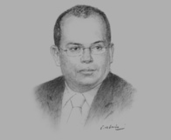OBG talks to Luis Miguel Castilla Rubio, Minister of Economy and Finance

Interview: Luis Miguel Castilla Rubio
In the face of a decelerating Chinese economy, what is your strategy to maintain domestic growth?
LUIS MIGUEL CASTILLA RUBIO: Peru has achieved growth at a rate of roughly 6.5% over the past decade, based on four separate but interrelated strategic pillars. First, sound economic policy has allowed us to retain gains made in periods of high commodity prices during less favourable times. In 2013 the country’s fiscal stabilisation fund will reach $8.5bn, which is equal to nearly 4% of GDP; additionally, the country will have public debt below 20% of GDP and $66.4bn in international reserves. Overall, we are expecting a 0.3% fiscal surplus for 2013.
Second, the country is constantly looking for new markets to increase trade and exports. In 2012 trade agreements with Mexico, Japan and Panama came into force and 2013 has already seen similar agreements with the European Union. Multiple other trade agreements are being negotiated with countries and entities around the world, including the Trans-Pacific Partnership, the Pacific Alliance, Qatar, Honduras and El Salvador.
Third, we continue to promote private investment as one of the primary growth engines. In 2012 private investment rose by around 14%, while commitments for 2013-14 add up to $32bn, with significant strength in the mining and energy sectors – although we understand the importance of diversification, and also see strength in the tourism, forestry and services sectors.
Finally, over the past decades the country has made significant strides to improve upon institutional inefficiencies, improve productivity and enhance competitiveness. To continue along this path, the primary goals are still reducing the infrastructure gap to connect underserved parts of the market, improving the country’s human capital, increasing public-private partnerships, diversifying exports and reducing red tape.
Even though Peru is performing well at the macroeconomic and business level, some challenges remain. Access to education, health and the justice system must be improved, and we have to work to reduce the urban-rural development gap by increasing access to basic services and improving infrastructure. It is essential Peru take advantage of this period of strong commodity prices and use it to leverage sustainable development. This includes encouraging research in key sectors, such as mining, fisheries and agriculture, while also boosting the development of new technologies to facilitate exports to even more markets.
How can regulators best balance the role of promoting the economy with that of regulation?
CASTILLA: The state regulators for public services are autonomous and independent bodies whose main goal is to enhance competition in regulated markets. Hence, they have to balance incentives and align business and policymakers’ objectives. We believe these are the main principles on which they should operate to promote efficiency, productivity and growth.
The Ministry of Economy and Finance is leading an initiative to improve the quality of regulations by analysing them, assessing the associated costs and benefits expected for all stakeholders, and considering all alternatives. The first and most basic step in this agenda is to increase the technical knowledge and skills of public servants so they are able to recognise existing problems and work towards resolving them.
What is the ministry doing to minimise the informal economy, and what are your main obstacles?
CASTILLA: The ministry is working to reduce informality through tax reform and other business-oriented policies. We are convinced that the informal economy makes the economy as a whole less productive, because it only creates low-wage and low-productivity jobs; informal firms are also unable to access the credit lines necessary to grow and create additional jobs. About 59% of the Peruvian economy is informal, while evasion of the general sales tax and income tax reach 35% and 50%, respectively. To rectify the tax situation, we are working to simplify the system, which should reduce taxpayers’ costs and streamline state operations.
You have reached the limit of premium articles you can view for free.
Choose from the options below to purchase print or digital editions of our Reports. You can also purchase a website subscription giving you unlimited access to all of our Reports online for 12 months.
If you have already purchased this Report or have a website subscription, please login to continue.

